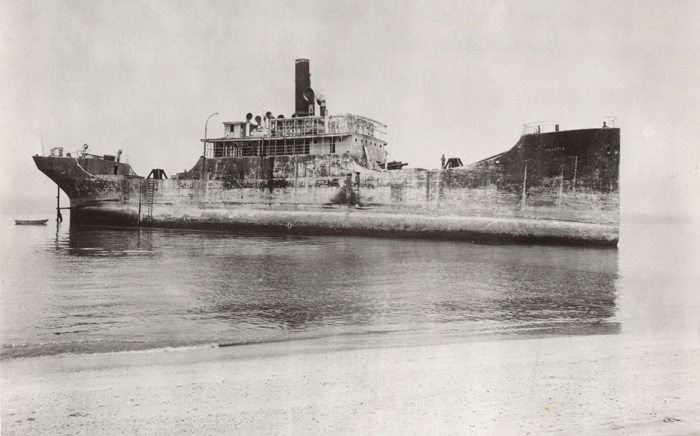SS Atlantus
Wreck Location
The Atlantus lies 150 feet off the coastline of Cape May, New Jersey in 20 feet of water in Delaware Bay. She is easily divable and is lying offshore at a public beach. She is a local tourist attraction abd is considered the most famous concrete ship of the 13 built. There is also a historical marker/plaque on the beach near her remains explaining briefly, the history of the strange vessel.
~ GPS Shipwreck Location ~
Latitude: 38° 56' 39.606" N Longitude: -74° 58' 19.2756" W
Description

(Atlantus aground in 1926.)
In 1917, a Norwegian engineer named Nicolay Fougner built the world's first concrete ship capable of moving under its own power; the MV Namsenfjord. Fougner visited the United States and by request of the American government, helped to launch a study into the construction of concrete ships. The first American concrete ship, the SS Faith was constructed in 1917 in Oakland, California. Ultimately, the studies undertaken by Fougner and the US government would lead to President Woodrow Wilson approving the construction of 24 concrete ships by the Emergency Fleet Corporation in 1915. The first two ships would be experimental singular prototype designs while the remaining 22 ships would be finalized production designs to be contracted to shipyards across the country. The EFC would finance the construction of special slipways for the concrete vessels to be constructed on.
In 1918, construction began on the first two ships. Atlantus was constructed at the Liberty Shipbuilding Company yard in Brunswick Georgia and the Polias was built at the Fougner Concrete Shipbuilding Company in Flushing Bay, New York. While Atlantus was the first to begin construction, Polias was the first to be launched. Both finished completion after the war had ended. None of the other 22 ships meant for the war use were finished before armistice on November 11, 1918 either. Atlantus was fortunate enough to have entered service in 1919 and was used by the US Government, returning American troops from Europe to the United States. The soldiers aboard weren't pleased with the Atlantus and one went as far as to coin the ship a "floating tombstone". In 1920, the Atlantus was retired and laid up. She would never steam under her own power again.

(Atlantus around 1940, starting to break up.)
In 1926, an enterprising businessman Jesse Rosenfeld bought the Atlantus and planned on using her and two other concrete ships to make a "Y" shaped ferry dock for a proposed ferry connecting Cape May, New Jersey to Delaware. Before the plan could be carried out, Atlantus broke loose under tow in a storm and ran aground 150 feet from shore at Cape May. The ship was unable to be refloated and was subsequently abandoned. By 1940, the ship had broken her back and was split in half amidships. By the 1950s, the bow and stern had begun shifting apart and sinking into the sand. The supserstructure was about gone as was the smokestack. She was used as a boat insurance billboard in the 1950s and 1960s. The ship continued breaking apart and sinking into the sand over the next 50 years.
As of 2016, the Atlantus was mostly underwater or covered by sand, apparently in three pieces. The stern capsized completely to port and lies on its side, partially above water. The bow is still mostly upright but is hardly above water. She is covered in marine growth and the ribs of the ship are showing, the starboard side having been rotted or blasted away. Atlantus was featured on an episode of the Travel Channel TV series "Weird US".
Footnotes
Atlantus was part of a series of ships built of concrete for the U.S. Military in the late 1910s early 1920s. Atlantus and Polias were both experimental singular designs and were built as prototypes for the EFC concrete ship program. During World War I, steel was a highly sought after material needed for warships and other high priority military equipment. Reinforced concrete was an easy to construct, strong and cheap alternative to steel. President Wilson approved the construction of an "Emergency Fleet" of 24 ships in 1918. Only 12 were finished, all after the war, and sold to commercial operators. Many ended up as fishing piers, breakwaters and shipwrecks. Only one is still afloat as a Powell River breakwater in British Columbia; the Peralta. The San Pasqual is also intact off the Cuban coastline, but is abandoned and likely not afloat.